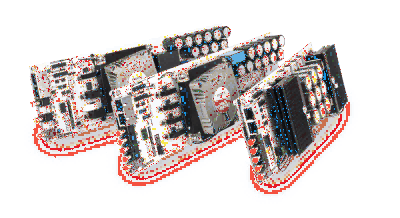The Future of Power Management: Trends in Power Module Innovations
The Future of Power Management: Trends in Power Module Innovations

Image source: Imperix
Today, power management has become a key area of focus in electronics. Manufacturers and researchers are always looking for the best ways possible to increase the performance of the power modules while at the same time reducing energy wastage. Technically, all industries are demanding faster and more efficient electronics. Devices and applications should be able to utilize the available energy to the maximum levels. The demand for performance tends to increase the energy consumption of such applications. This leads to a direct increase in the energy expenses. This has an overall impact on the cost of running a business.
In most industries, electricity expenses constitute up to 45 percent of the total running expenses. This tends to vary from one industry to another. Such expenses tend to block some manufacturers and innovators from fully exploring their potential.
Additionally, attention has been drawn to the impact of energy on the environment. As consumers demand performance from electronic systems and applications, it is impossible to ignore the impact that these systems have on the environment. Modern power modules should strike a balance between the performance and the energy impact.
Power modules seem to be at the center of all the power management issues. The main function of power modules is to manage the conversion, transfer, and usage of electric energy in various applications. All the electronic devices and applications have power modules. The modules have also been evolving concurrently with the evolution of the power management. In this article, we are going to look at the future of power modules about power management. We will cover some of the trends and innovations in the power modules.
Increasing power density
In the world of electronics, power density is defined as the amount of power output per unit volume. It measures the volume that is stored and produced per the size. In recent years, manufacturers have been focusing on increasing the power density of devices, systems, and applications. However, this has been a difficult task for one to achieve, especially with the miniaturization of electronic devices. It means that manufacturers are forced to get maximum power from small energy-storage units.
Modern power applications such as smartphones, electric vehicles, and many other consumer electronic devices are designed to be small. This forces designers to squeeze many electronic components into a small area. While doing so, they should be able to achieve maximum thermal management and energy efficiency. In such applications, the focus is on power modules.
There are various ways in which manufacturers increase the energy densities of the power modules. One way is by increasing the operating frequency of the individual electronic components that make up the power modules. They are forced to do so while at the same time minimizing the switching losses on the power modules. To achieve power density, manufacturers are using more advanced materials to manufacture their electronic components.
Lowering quiescent current
In the field of electronics, we can define quiescent as the state or dormancy whereby the device is not running or executing any significant action that it is intended to. Since energy conservation is one of the key topics in modern power applications, manufacturers are focusing on reducing the energy consumption of their devices. One of the ways is by minimizing the quiescent current. This means that whenever the device is not in use or is not running, you will not have to worry about the wastage of current due to Iq.
The latest modules of power modules are designed to have low quiescent current. This ensures that devices that rely on these modules will have excellent energy ratings. However, there are some demerits of lowering the Iq. One of them is a decreased response time. This means that power module manufacturers should strive to strike a perfect balance in lowering the magnitude of Iq while at the same time getting fast response times from their devices.
Isolation of power components
Isolation is one of the emerging trends in power electronics. This refers to the separation of circuits in a device and application. It happens on both AC and DC circuits. One reason for the isolation is to protect one circuit from unexpected incidents on another circuit. For example, a surge in the high-voltage circuit should not affect the low-voltage circuit.
The main reason for isolation is safety. Through galvanic isolation, it is possible to separate functional sections of an electronic system and application. It eliminates any possibility of having a direct conduction path in a circuit. However, it still allows the exchange of power between different sections only that safer solutions are used for implementing such exchanges. Isolation also makes it easier to work on electronic applications. Engineers can easily work on one section without interfering with another. For example, manufacturers are widely embracing the use of capacitive silicon oxide barriers to isolate and insulate electronic components.
Emergence of IGBT power modules
To keep up with the ever-growing technology, there has been a gradual emergence of IGBT high-power modules. These are mainly used in emerging application areas that utilize power modules. The automotive industry is one of the areas in which IGBTs are used. Quite a good number of industrial and commercial applications are also taking advantage of this technology of power modules.
IGBT power modules cover all the popular voltage ranges that are used in high-power applications. This explains their suitability in most industrial applications. They are highly flexible and scalable. Manufacturers can easily modify the target applications to meet different power needs.
IGBT power modules also offer robust architectures and come with high levels of reliability. These power modules can still thrive in harsh environmental conditions. It is also easy to integrate these power modules into different devices, including small or compact devices.
Power modules for renewable energy
Over the years, there has been a gradual shift towards renewable energy. There are many reasons for this and among them is the need to conserve energy. Power module manufacturers are also developing modules that are suitable for the new forms of energy. This is necessary given the rising popularity of renewable energy.
New-generation power modules are used in solar and wind energy. Their main function is to facilitate the conversion of energy from one form to another, from solar to electricity or wind to electricity. Renewable energy power modules are built into device drives that are directly involved in the conversion and generation of electricity. Some are integrated into the control and protection systems of renewable energy systems.
When it comes to wind energy, power modules are integrated into wind power converters. These modules are made of premium-grade semiconductor materials that are sensitive to any mechanical energy generated by the windmills. The same applies to solar power modules which are integrated into inverters.
Power modules in electric vehicles (EVs)
We cannot deny the fact that electric vehicles(EVs) are the trendiest topic in the auto world. Since they rely on electric energy, there is a direct relationship between EVs and power modules. Power modules are designed to meet the different needs of electric vehicles. With every new EV-related technology that is released, it has to be in line with the power modules.
Power modules are used to facilitate the charging process in electric vehicles. These modules have features that control the flow of electric charges from the charging station to the battery pack. Additionally, the modules play a protective role whereby they prevent overcharging of the battery packs.
Power management is one of the key functions of power modules in electric vehicles. You can tell the battery charge that is in the battery thanks to the power modules. Furthermore, these modules optimize energy usage in EVs. They do this by ensuring that you can get the best performance from batteries without draining power within short periods.
Other than pure electric vehicles, power modules are also used in hybrid electric vehicles mainly for power conversion. They are found in regenerative brakes whereby they convert energy from mechanical to electric.
Conclusion
All the key players in the electronics industry are prioritizing power management. Manufacturers are doing all that it takes to provide effective and sustainable solutions that consumers need. On the other hand, consumers are keen on lowering their energy expenses even as they intend to get the best results from their solutions. The best way of finding a perfect balance is by embracing the trends and innovations in the power modules. After all, these modules are responsible for everything that entails power management.
As a manufacturer, you should be keen on the latest innovations on the power modules. This will ensure that you incorporate the right module into your product. One way of achieving this goal is by working with the right power module suppliers and distributors. They will always update you on the latest developments in the industry. This is exactly what you stand to gain when you choose Rantle Electronic. We are a global supplier of power modules. We have been in this industry for over 20 years and are always up to date with the latest developments in the power modules.
Kevin Chen
Founder / Writer at Rantle East Electronic Trading Co.,Limited
I am Kevin Chen, I graduated from University of Electronic Science and Technology of China in 2000. I am an electrical and electronic engineer with 23 years of experience, in charge of writting content for ICRFQ. I am willing use my experiences to create reliable and necessary electronic information to help our readers. We welcome readers to engage with us on various topics related to electronics such as IC chips, Diode, Transistor, Module, Relay, opticalcoupler, Connectors etc. Please feel free to share your thoughts and questions on these subjects with us. We look forward to hearing from you!







 Start With
Start With Include With
Include With


